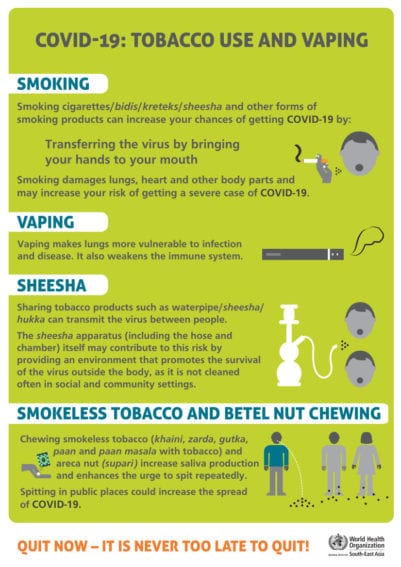22/02/21
Youth kick the butt, favour other tobacco fixes

By: Sanjeet Bagcchi
Send to a friend
The details you provide on this page will not be used to send unsolicited email, and will not be sold to a 3rd party. See privacy policy.
[NEW DELHI] While cigarette smoking has decreased among adolescents globally, a shift towards the use of other tobacco products such as electronic cigarettes threatens to reverse the gains and highlights the need to strengthen tobacco control efforts, says a new study.
Published this month in The Lancet Child & Adolescent Health, the study relied on data from the Global Youth Tobacco Surveys during 1999—2018 to assess trends in tobacco use and looked at more than 1.1 million adolescents aged 13—15 years from 140 countries.

In 2020, the global tobacco industry was valued at US$932.11 billion and it is expected to expand to US$1.074 trillion by 2028, according to Grand View Research, an agency that analyses international markets and is based in the US and India.
Tobacco kills more than eight million people around the world annually and can lead to cancer, diseases of the heart and lung as well as other ailments, according to WHO. Among the youth, the short-term consequences of smoking include respiratory and non-respiratory effects, addiction to nicotine, and the risk of other drug use.
The study reported that the prevalence of cigarette smoking decreased in 80 countries, was unchanged in 39 countries and increased in 21 countries during the period studied. However, the use of tobacco products other than cigarettes — including chewable tobacco, snuff, dip, cigars, cigarillos, pipe or electronic cigarettes — was unchanged or increased in 81 countries.



Poster from WHO South-East Asia warning about how tobacco products can increase the chances of getting COVID-19. Image credit: WHO South-East Asia.
Yajun Liang, co-author of the study and assistant professor, department of global public health, Karolinska Institute, Sweden, says the study findings suggest a transition from cigarette smoking to other tobacco products in adolescents.
“This implies that more efforts are needed to control the use of non-cigarette tobacco products among adolescents in various countries,” she tells SciDev.Net.
“More efforts are needed to control the use of non-cigarette tobacco products among adolescents in various countries”
Yajun Liang, Karolinska Institute
The study showed that the highest prevalence (42.2 per cent) of non-cigarette tobacco use was reported from Kiribati — an island country in the central Pacific Ocean. The lowest prevalence (0.3 per cent) was reported from Turkmenistan in Central Asia.
The use of tobacco products other than cigarettes was highest in the Eastern Mediterranean region (16.7 per cent among boys and 9.0 per cent in girls). The Americas and European regions had the lowest prevalence (7.5 per cent and 9.3 per cent among boys and 5.4 per cent and 5.5 per cent among girls respectively), a press release relating to the study said.
Joanna Cohen, director, Institute for Global Tobacco Control at the Johns Hopkins Bloomberg School of Public Health, Baltimore, US, says that it is “concerning that the prevalence of the use of non-cigarette tobacco products did not decline in over 80 of the countries studied. No tobacco product is safe, and adolescents are particularly vulnerable to harms from these products and the risk of life-long addiction”.
Agnimita Giri Sarkar, a paediatrician at the Institute of Child Health, Kolkata, India, and founder secretary of an Indian organisation, Disha for Cancer, tells SciDev.Net that the use of non-cigarette tobacco products among adolescents makes them prone to suffer from premature cardiovascular diseases, dental problems, fractures (due to low bone mass), lung disorders and cancers.
Sarkar hopes to see governments and non-governmental organisations promoting mass anti-tobacco campaigns, implementation of rules to prohibit tobacco use and sale in public places, including in bars and restaurants.
Cohen suggests increasing the price of tobacco products through tobacco taxes, restricting advertising and promotion of all tobacco products, and effectively informing the public about the harms of tobacco products through warning labels on tobacco packs and hard-hitting mass media campaigns as ways to reduce tobacco-related death and disease.
Liang says further studies are needed to determine which non-cigarette tobacco products are predominantly used by adolescents so that specific tobacco control measures may be planned.
This piece was produced by SciDev.Net’s Asia & Pacific desk.














